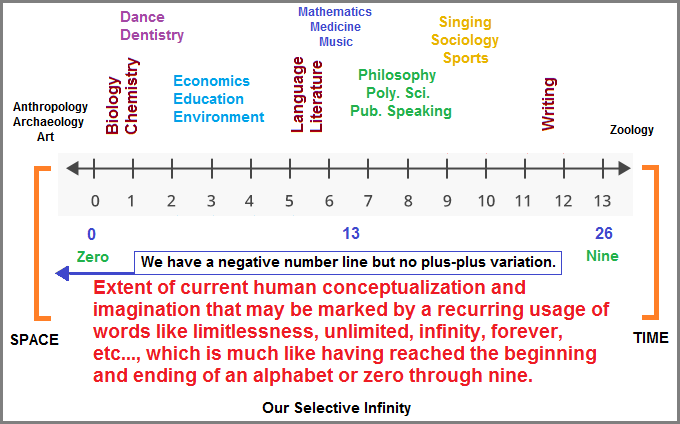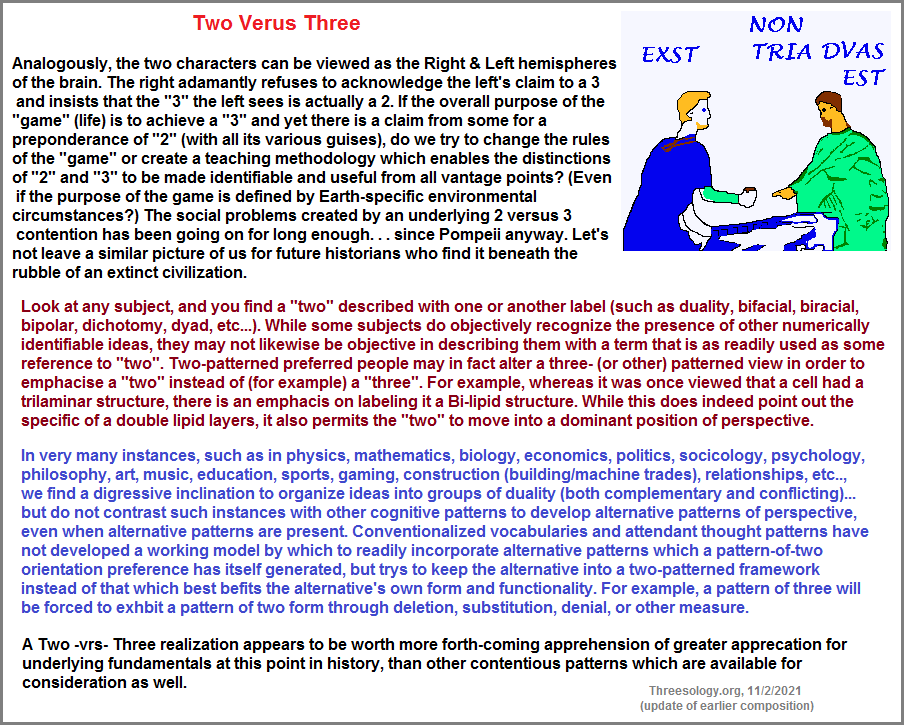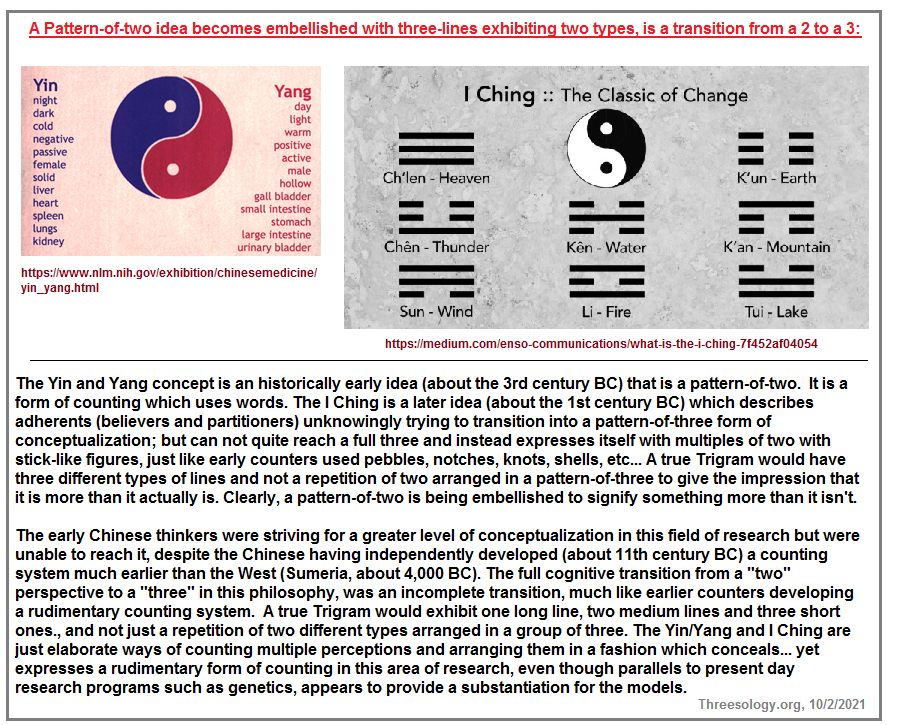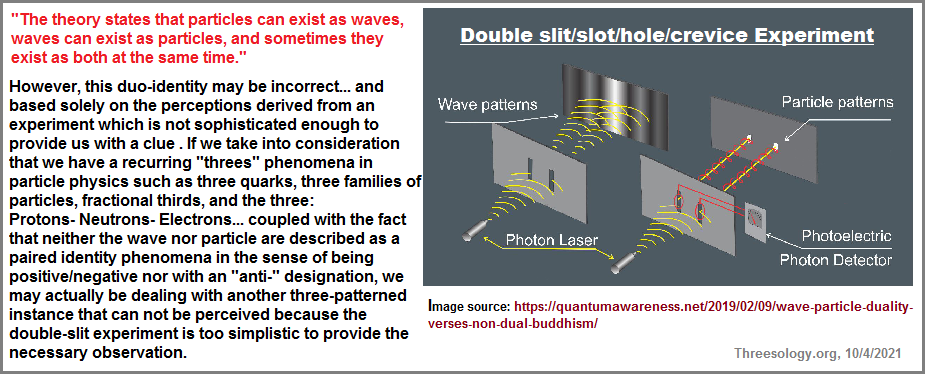page 8
~ The Study of Threes ~
http://threesology.org
| Hybrids page 1 | Hybrids page 2 | Hybrids page 3 | Hybrids page 4 | Hybrids page 5 |
| Hybrids page 6 | Hybrids page 7 | Hybrids page 8 | Hybrids page 9 | Hybrids page 10 |
| Hybrids page 11 | Hybrids page 12 Playmate God |
Hybrids 13 Economics 1 |
Hybrids 14 Economics 2 |
Hybrids 15 Economics 3 |
| Hybrids 16 Economics 4 |
Hybrids 17 Economics 5 |
Hybrids 18 Economics 6 |
Hybrids 19 Economics 7 |
Hybrids 20 Language 1 |
| Hybrids 21 Language 2 |
Hybrids 22 Language 3 |
Hybrids 23 Language 4 |
Hybrids 24 Physics |
Hybrids 25 |
| Hybrids 26 | Hybrid 27 |
Visitors as of 30th July, 2021

Let me again state it simply that Hybrids involve combinations... but those combinations are sometimes used to befuddle truth, such as representing something of a superior nature when in actuality, the hybridated idea is merely a repetition of a simple idea labeled as being superior when it honestly isn't.
Other hybrids are created to represent themselves as being simple and naive when they are actually a masterful idea truly representing a step beyond the convention... the norm... a norm that may be held up to be THE last word of a given topic which no one is supposed to question, because there are so many who may well have their professional reputation attached to and will do anything to keep it intact.
Sometimes by simply changing labels or placement of a current label into an unconventional setting, we can uncover a truth that a former label obfuscated when applied in a particularly usual application— and denied entry into any alternative consideration, such as the terms dark energy and dark matter... which are references which laughingly remind me of those old phrases "Secret decoder ring", "Secret password/handshake", "(secret" project X"), etc.., once often heard decades ago in childhood, and quite reminiscent of secretive intrigues which took place in medieval times. We fail to remember that humans are a superstitious and fearful creature that is still afraid of the dark, or people would not walk down a dark street in the middle of it, and perhaps even whistle as they do so while looking and listening intensely for anything suggesting that which one should run from. And yet, if one were to seek what percentage of adults were afraid of the dark, different cultures might provide different percentages, such as those who... as a nation... suffered an intense fear during the darkness of being attacked, like Britain in World War II. However, the context and questioning one uses to elicit an answer about fear can alter the result. If one simply asks if a person is afraid of the dark as opposed to be asked what they are afraid of, that which is sought may or may not be easily identified. Fear in terms of an anxiousness as opposed to a full-blown panic reaction are different issues. The former can be said to be a behavior developed in the distant hominid past while the panic-level fear can be considered abnormal for most people.
- It's Not Just You: Lots of Adults Are Afraid Of the Dark by Korin Miller, February 15, 2017
- This is the percentage of adults who are still afraid of the dark by Grace Beck (British Study)
- There's an Evolutionary Reason Why We're Afraid of The Dark by Josh Hrala, 18 Feb. 2016
he evolution of superstitious and superstition-like behaviour,br> by Kevin R Foster1, and Hanna Kokko
Abstract
Superstitious behaviours, which arise through the incorrect assignment of cause and effect, receive considerable attention in psychology and popular culture. Perhaps owing to their seeming irrationality, however, they receive little attention in evolutionary biology. Here we develop a simple model to define the condition under which natural selection will favour assigning causality between two events. This leads to an intuitive inequality—akin to an amalgam of Hamilton's rule and Pascal's wager—-that shows that natural selection can favour strategies that lead to frequent errors in assessment as long as the occasional correct response carries a large fitness benefit. It follows that incorrect responses are the most common when the probability that two events are really associated is low to moderate: very strong associations are rarely incorrect, while natural selection will rarely favour making very weak associations. Extending the model to include multiple events identifies conditions under which natural selection can favour associating events that are never causally related. Specifically, limitations on assigning causal probabilities to pairs of events can favour strategies that lump non-causal associations with causal ones. We conclude that behaviours which are, or appear, superstitious are an inevitable feature of adaptive behaviour in all organisms, including ourselves.
When I look at one subject to the next, what I see are particularized ways of measuring and labeling a subject's peculiarized consensus of contemplations arranged in a subject-specific ways -and- means aptitude (which is) familiarized into a line-up resembling a counting sequence, though many people interested in and who use a given subject as a hobby, or as an intelligent lay-person, or professionally, may not even recognize they are engage in an act of counting... often times in a rudimentary fashion; because the material being analyzed is reduced to basic models and forms which can be numerically reduced to basic numbers. And even though Mathematics presents itself with declared complex and sophisticated models of examination called geometry, algebra, trigonometry, calculus, combinatorics, etc., they too are commonly reduced to simplified expressions resembling basic number lines. However, the language and setting (context) employed as a means of conveying the basic number lines may use symbols and words by way of behaviorally expressed embellishments that give the impression of having uncovered something other than a basic number line, the expressions are routinely multi-layered deceptions providing one or more illusions of some higher-order perception having been revealed, but the discerning eye detects the underlying basic alignment and arrangement which may be otherwise represented by a practiced con-artistry or manipulative advertisement ability which conceals an elaborate self-deception that genuinely believes oneself is engaged in an objective form of Devil's Advocacy concerning one's efforts. There is a psychology of counting few people are aware of.
Just as we can create a list of subjects and place them along a left-to-right (etc., horizontal, diagonal, vertical) number line in a successive alphabetical arrangement, every subject uses its own model and arrangement of its perceptions which may not use an alphabetical form of listing. In some cases words can be identified which directly correspond to numbers such as duality and trichotomy, where as at other times two, or three, or four, etc., items may be offered in a non concurrent fashion unless someone on the outside of a given subject takes the time to arrange them into a sequential order. Quantities are frequently referred to though the use of numbers and words identifiable as numbers may not be used, though a topic itself is arranged in a fashion of discussion which is organized in a before, during and follow-up fashion that can be enumerated. And even though mathematics uses numbers, individual disciplines in mathematics as well as the whole of mathematics is an overall counting system, that is top-heavy with the usage of dichotomies, dualities and other "two" preferences such as "squaring". One can not be fooled by the context, by the titles of the person speaking, by the proposed application, nor position, money or gender involved. The usage of various models of hybridation can be seen as camouflage, reflective surfaces, distraction, deflection, sleight-of-hand combinations that take on the portraiture of stage scenes, props and scripting for whatever audience is targeted... and many of the players involved are not even cognizant of such. Though a given subject uses its own type of number line, we nonetheless can detect some variation of a mean, medium and mode... even when there is a less than or more than three arrangement being preferred by a given person using their preferred instrumentation and ornamentation. Whereas they may have definitely defined limits mapped out in their subject, another person may claim their limits are limitless, yet such an idea is a means of expressing their limitation of an ability to describe that which is beyond present human conceptualization without referring to a label that is itself an expression of a limited imagination.
Here is a simplified model of enumerated subjects arranged alphabetically as an alternative type of counting theme. The initial 1-13 designations came with the line as I downloaded it so I just kept it without intending for it to mean anything specific, but should not confuse the realization that, like the alphabet, is an expression of a numbering limit from zero to nine, with supposed boundaries being transgressed by using a method of hybridization where numbers are placed together to give the impression of more (like an increased population), but obscures the fact that mere repetition is taking place and no actual increase in conceptualization. Even our idea of negative numbers is a mirror image of regular numbers assigned with another name called positive of plus, and yet we do not have a scale for plus-plus numbers or some number greater than 9 with its own designation which we teach in elementary school:

While many view Mathematics as a fundamental means of understanding basic bottom line phenomena regardless of subject, different subjects and their sub-disciplines: each have a perspective which views their approach is most fundamental to their respective interests. Many of them resort to the usage of dichotomies. For example, in Linguistics there is the dichotomy of Formalism and Structuralism (also referred to as the generative versus evolutionary approach); Difference Between Structuralism and Formalism by Hasa, October 30, 2016. There also is the idea of Descriptive versus Prescriptive, such as in grammar: Understanding Prescriptive vs. Descriptive Grammar by Amy Reynolds. Similarly, we find many views expressed by the old dichotomy of Nature Versus Nurture in Psychology by Saul McLeod, updated 2018.
Every subject you look at has their own distinctly labeled variety of dichotomies. While some do express a trichotomy, not all trichotomies are formally identified and discusses as a differentiation from a duality perspective. Several religious writers have made an effort to point out the contrast such as:
- Trichotomy vs. dichotomy of man—which view is correct?
- Difference Between Dichotomy and Trichotomy
- Monergism: Trichotomy vs. Dichotomy
In one respect, the study of theology which fully recognizes and tries to address the duality of 2 versus 3, in another respect they don't delve into the existence of such in all the other subjects. The other subjects refrain from using the word "Trinity" to highlight the presence of three-patterned orientation (idea/view) in their domain of interest, and instead focus unevenly on the circumstance by using words such as duality, dichotomy, bilateral, bifurcation, pair, mirror-image, twin, dualistic, dyad, etc...: (Your Dictionary: "Two" synonyms). They will quickly resort to the usage of a "two" word, but upon seeing a pattern-of-three in their midst, do not automatically address the observation by applying a "three" word, since in several cases there is no standard word being used. Take for example the word "functionalism" as cited above. It is sometimes combined with the notions of post-functionalism and deconstruction, but such a three-patterned cognitive structure is not identified as a pattern-of-three taking place in a context where the two-patterned dichotomy of Structuralism and Formalism are apparent or on the mind of/in the memory the those with such a perspective.
The two versus three contention has been going on a long time, it is just that many subjects attempt to disregard or conceal the presence. The following image portrays the two versus three in an old game played in Pompeii:

The above dicers image was found by me in an art book several decades ago. I used it as a caption for the eight column of an old poster I had printed up. You can see the poster here: Threes Posters; and the column's information here: Threes Poster column 8. You can also see an image here: Pompeii Fresco of men playing a dice game, though there are other sources as illustrated by the following series of images:

Yet another search to find the image with the caption led me to this:
Wall painting - scenes around the pub - Pompeii (VI 14 35-36)
Although I have already mentioned the yin/yang series of dualities, let me emphasize that it too is involved with a 2 versus 3 situation although most people involved with it do not see the presence of such. It is subtle... much like the development of humanity's counting sequence which, early on, started with the value of one, an then stopped. The on to two, and then another stop. At some point beyond two (let us suspect), and perhaps then beyond one... the idea of many, much, heap, more was signified, though no specific enumeration. Like the start and stop codons seen in genetics, the counting sequence of humanity was fitful, piece-meal, and not necessarily as smooth as some might want to convey in an attempted historical and approximated retelling. The point to make is that there were transitions of cognitive development that we of today overlook as a collective species, though we speak of developmental milestones concerning stages such as infancy, childhood, teenager, young adult, middle age, and senior citizen. We fail to recognize that the early schemes of cognitive development play out in our supposed intellectually astute ideas and modeling. Whereas we might say that the development of numbers portrayed a manner of one, two, many.... as a general reference which need not have taken place in a literal sense for every culture, the point is we do not readily know how to recognize transitional representations of cognitive development of ideas being developed in settings where other ideas are more developed, are more mature. Immature ideas are not necessarily easy to recognize being developed by a professional if they use vocabulary customarily used to describe more developed ideas.
With respect to the Yin/Yang usage of "two" being displayed by multiple examples, and the I-Ching referencing an idea using the word "Trigram", it is difficult for many to see that the Chinese mindset of the time was in a transition from the "two" to the "three" in cognitive development, but it could not and is not recognized as a transition between the two and not a fully developed "three", because of the setting in which it occurs and the many who use the word "Trigram", not necessarily acknowledging the underlying cognitive transition (The I Ching came after the YIN YANG), whereby its application in the context with the twos of the Yin Yang perspective, was... I submit, felt to be a higher cognitive step of development in the philosophy. Unfortunately as already pointed out, the Trigrams are actually Bigrams masquerading as (a comprehensive step forward in 'perceptualization' involving some portraiture of) "threes", by using three lines which were doublings, or mirror-imaging effects of asymmetry similar to the disposition of examples found in the Yin Yang conceptualization.

Once it is noticed, it is recognized that there are no three distinct types of line, only two types which come to be repeated... that is, reflected. The so-called I Ching Trigrams are actually embellished Bigrams masquerading as Trigrams, and thus represent an ancient Chinese cognitive development that was in transition. It is a transition which is being perpetuated by those who do not understand cognitive development can in some ways be identified numerically, and that by so doing we can pin point at what state of evolution a person, a group or even a species is stuck in. The same two/three transition is seen in multiple subjects and frequently shows itself as a contention and not as a complementary situation as the yin/yang does in many explanations thereof. Whereas the I-Ching is using a stick-like means to (unknowingly) conceal the presence of an attempted transition into a higher model of conceptualization, many subjects use different methods such as a complete dismissiveness, denial, deliberate obfuscation, or some other tactic which the person or group may not even be aware that they are doing so.
However, in dealing with professionals and lay persons alike, trying to get them to see their assumed ideas as representing a low level of cognitive development sustained by the vocabularies and models of deployment they are using to portray ideas as if they are cutting edge superiority, is like trying to ween a bottle, security blanket or favorite stuffed animal from them.
The anatomical references of TOE and GUT are used as references such as the Theory of Everything and the Grand Unified Theory. Some readers may have mused about other three-lettered words being used for a similar purpose such as EAR, EYE and BUM, but I'll leave making up similarly appropriate ideas to their imaginations. What I want to describe is the effort to get to the bottom of ideas and come up with a single idea that will explain life, death, the universe, laughter, love, jokes, etc., Each of us in our own fashion try to peel away at perceived layers to get to the bottom, the most definitive understanding of a given topic. Whereas a person who doesn't cook or bake may think a chef and baker are geniuses for what they do, the amount of understanding that a chef and baker have is only one level of rudimentary knowledge... which brings me to point out that some topics do not have existing layers of possible knowledge which equals other subjects. For example, a cook may use various ingredients and view themselves as a type of chemist, yet a chemist who studies chemistry deals with ingredients and mixtures at the molecular level. And physicist, though they may not refer to themselves as chemists, nonetheless look at the ingredients of atoms in an effort to understand the composition... though they many not actually be able to use their information in creating anything that is palatable to the average person's intellectual tastes.
We can study one subject for years in an effort to master the content of ideas submitted as points of truth, and never once ask ourselves is the basic structure of components being presented actually the most definitive truth or approximation. A mechanic, for example, may think they have reached the ultimate level of understanding if they can fix almost any problem which arises in the vehicles brought to them for repair, while other mechanics may think about development of fuels, engine design, exhaust design, frame and body design, etc...
In the filed of computer coding, there is a layering effect though on one level it is abbreviated as CSS (Cascading Styled Sheets), which forms one of three cornerstone technologies for making the internet as serviceable as it is and named the WWW, or World Wide Web. The other two cornerstone layerings are HTML ( Hyper-Text Markup Language), and Javascript, though in the History of the Web the originator of the Web (Tim Berners) is cited for having developed "three fundamental technologies that remain the foundation of today’s web (and which you may have seen appear on parts of your web browser":
- HTML: Hypertext Markup Language. The markup (formatting) language for the web.
- URI: Uniform Resource Identifier. A kind of "address" that is unique and used to identify to each resource on the web. It is also commonly called a URL (Uniform Resource Locator).
- HTTP: Hypertext Transfer Protocol. Allows for the retrieval of linked resources from across the web.
More often than not, when the word "cornerstone" comes up, the idea of four cornerstones may come to mind representing a square structure and not a tripodal or bipodal nor monopodal construction, much less more than four corners. "Cornerstone" is a word which references cognitive development as a portrait of its limitations... like a word which is being used to describe a counting limit like in the three-patterned counting sequence phrase of 1, 2, many (much, heap, more, plenty, etc..), which, by the way, has no zero.
Clearly early peoples dealt in their own way with size (length, width, depth), shape, color, weight, and quantity, among other perceptions as temperature, hunger, thirst, etc... The point is we of today can actually only image what it must have been like when there were no words for such concepts, much less specific labels for a given specificity. Take for example the absence of the color "blue" in the past that we of today take for granted:
There's Evidence Humans Didn't Actually See Blue Until Modern Times by Fiona MacDonald April, 2018Human vision is incredible - most of us are capable of seeing around 1 million colours, and yet we still don't really know if all of us perceive these colours in the same way. But there's actually evidence that, until modern times, humans didn't actually see the colour blue.
As Kevin Loria reported for Business Insider back in 2015, the evidence dates all the way back to the 1800s. That's when scholar William Gladstone - who later went on to be the Prime Minister of Great Britain - noticed that, in the Odyssey, Homer describes the ocean as "wine-dark" and other strange hues, but he never uses the word 'blue'. A few years later, a philologist (someone who studies language and words) called Lazarus Geiger decided to follow up on this observation, and analysed ancient Icelandic, Hindu, Chinese, Arabic, and Hebrew texts to see if they used the colour. He found no mention of the word blue.
When you think about it, it's not that crazy. Other than the sky, there isn't really much in nature that is inherently a vibrant blue. In fact, the first society to have a word for the colour blue was the Egyptians, the only culture that could produce blue dyes. From then, it seems that awareness of the colour spread throughout the modern world...
(The article continues with more information.)
In dealing with the topic of hybrids as an expansion and reframing of topics that the reader may have previously viewed or not, I hope to introduce a path of conceptualization which forces an otherwise closed mindedness to react in a way that is not customary, and therefore sets into motion a reflexiveness which jars sensibilities into a position of awkwardness which requires them to seek out some alignment, some conscious equilibrium they would not have previously considered because they were never confronted by such a detour, bump in the road, pothole, cul de sac, or dead end. Yes, by deliberately putting up obstacles one can jar another's perspective to think differently, particularly if they have a mind that is working on a particular project in a particular way because they have carved out a path which they think is most profitable, and have no one to suggest otherwise. If I have to throw a snowball at your windshield in order to distract you long enough to widen your vision in search of the culprit who dares disturb your singular orientation, you might forget to look at the instrumentation of the world in your little box (vehicle) and contrast it with the actual environment outside the box our mind has framed as a comfort zone.
There was a time a couple of decades ago a young man was playing his car stereo quite loud. I went over to him and suggested to him that he turn it up, instead of asking him to turn it down as he probably thought I was going to do. I also said that he needs to park his vehicle nearer to the street and even put a sign on the vehicle that he has a brand new loud stereo. He was dumbfounded of course until I explained the situation that a lot of people were out of work and needed cash money. His advertising of the new stereo and large speakers he got was a calling card for all those thieves who were experts at breaking in cars. At first, with great bravado he said no one can break into his car and if they tried he would take care of them. I simply asked how would he know if they did it at night and were very skilled at what they do? He fumbled an unintelligible response. I then walked away and a very short while later he turned off the stereo and never turned it on again. Fortunately, he was smart enough to accept the different perspective with the intent to which it was being provided, and not act negatively to the extent that it caused him to create a chip on his shoulder.
Creating hybrids is an act of fabrication, whether you have math equations and one or more colleagues to back up your views or not. Look about the world and you see fabrications and multiple artificialities such as electric light used to mimic day time light. We have joints, organs and limbs which are replaced. Yet, removal of such also creates other types of hybrids as well. Absence as will as addition serves the premise of being a hybrid, like the half of an apple is the hybrid of a whole one. Negative numbers are a hybrid of positive ones, just as the plus and minus signs are hybrids of one another representing a mirror image, or pairing. However, let me ask if a pair is always a hybrid... and for that matter is a mirror image or echo or shadow always a hybrid? If one causes another, does it automatically always mean that we are dealing with a hybrid, or can both be separate singular issues simply occupying a similar context, like a wave an particle? By extension, is the Wavicle simply a created hybrid caused by the type of experiment used on particles? (Physics in a minute: The double slit experiment) If the Double-slit experiment created the image of both waves and particles from the usage of particles in the experiment, let us ask if the obverse is also true?
Nope, waves set against a double-slit do not create their own reflection of a particle. There is no parity in the experiment. It can not be flipped around as one might apply a simple math property (Division is said to be the multiplication of the inverse and Subtraction is the addition of a negative; leaving both without specialized properties.):
Three main properties of addition and multiplication:
- Associative
- Commutative
- Distributive
- Identity
In the particle-used, two-slit experiment... the identity changes to a wave and particle... like a yin/yang or Janus figure... or.... In the wave-used experiment the identity remains the same, it is conserved. In the former we are not working with either addition or multiplication because there is an identity change in terms of our perception. In the latter, it appears we are working with addition and multiplication in the sense that the way the experiment is set up, because the properties are violated. Now, if we try to run the experiment by keeping both a particle and image stationary, and moving a double-slit object towards them, we can only wonder what might occur. In addition, the acceleration of a presumed particle in an accelerator is accelerating both a wave and particle if particles have a duo-type of identity, yet only the particle half(?, third? 2/3rds?) of the duo is given priority or we would call the machines wave accelerators as well. No less, the question arises as to whether the "split" is even or there is actually a third identity not being accounted for because the experiment is too simplistic to detect that which would then makeup a reference equal to the other "threes" found in physics. While some think that a particle is paired into a wave/particle duo, we do not hear about a difference of charge nor an "anti" contemplation. Hence, we may be dealing with a situation in which there is a third identity just like there are three quarks, three large sub-atomic particles, and three families of particles.
If the particle is to be viewed according to one mathematical criteria and the wave another criteria, what have we done but used a type of experiment dealing with an irrationality of perception akin to a: Fluctuating asymmetry in our consciousness.

Date of Origination: Friday, 30th July, 2021... 6:38 AM
Date of Initial Posting: Monday, 4th , 2021... 7:30 AM